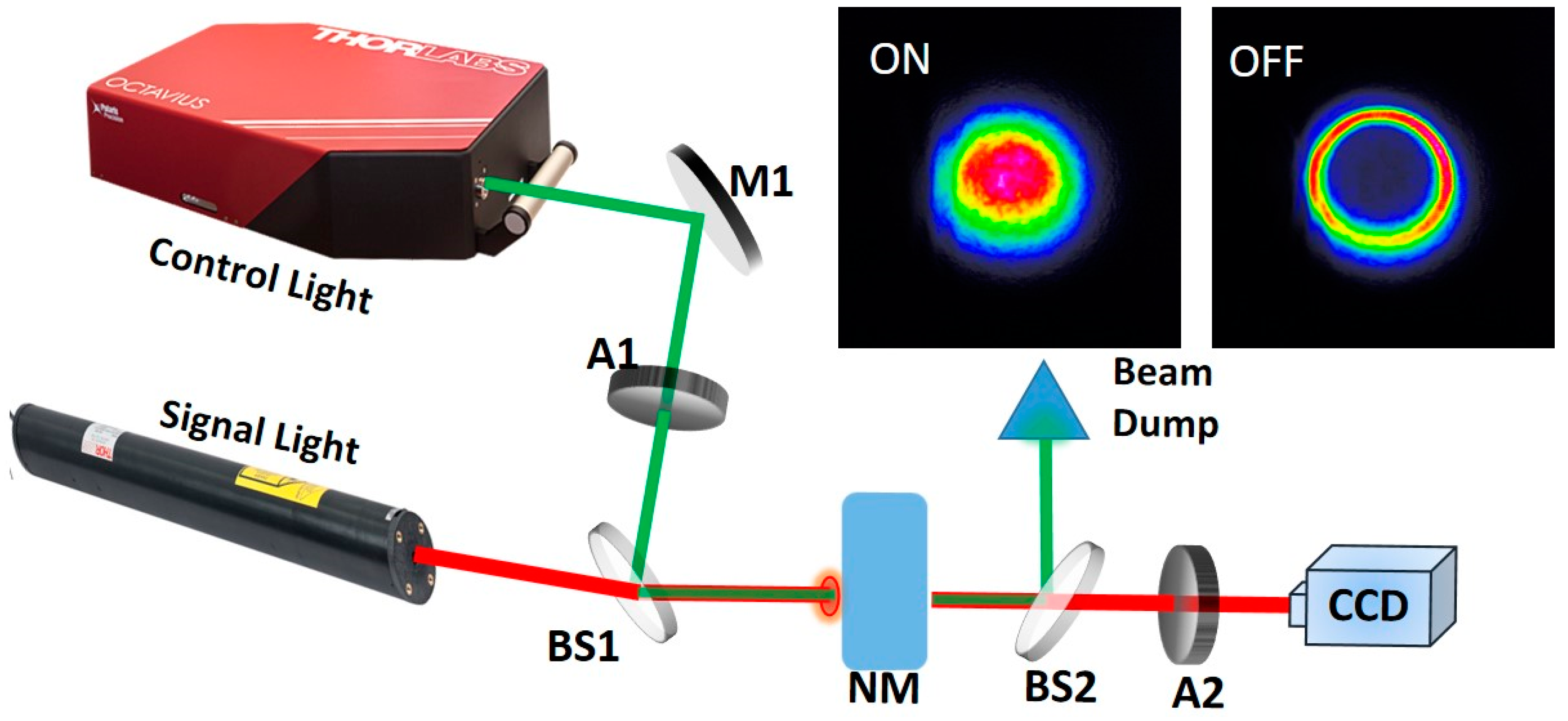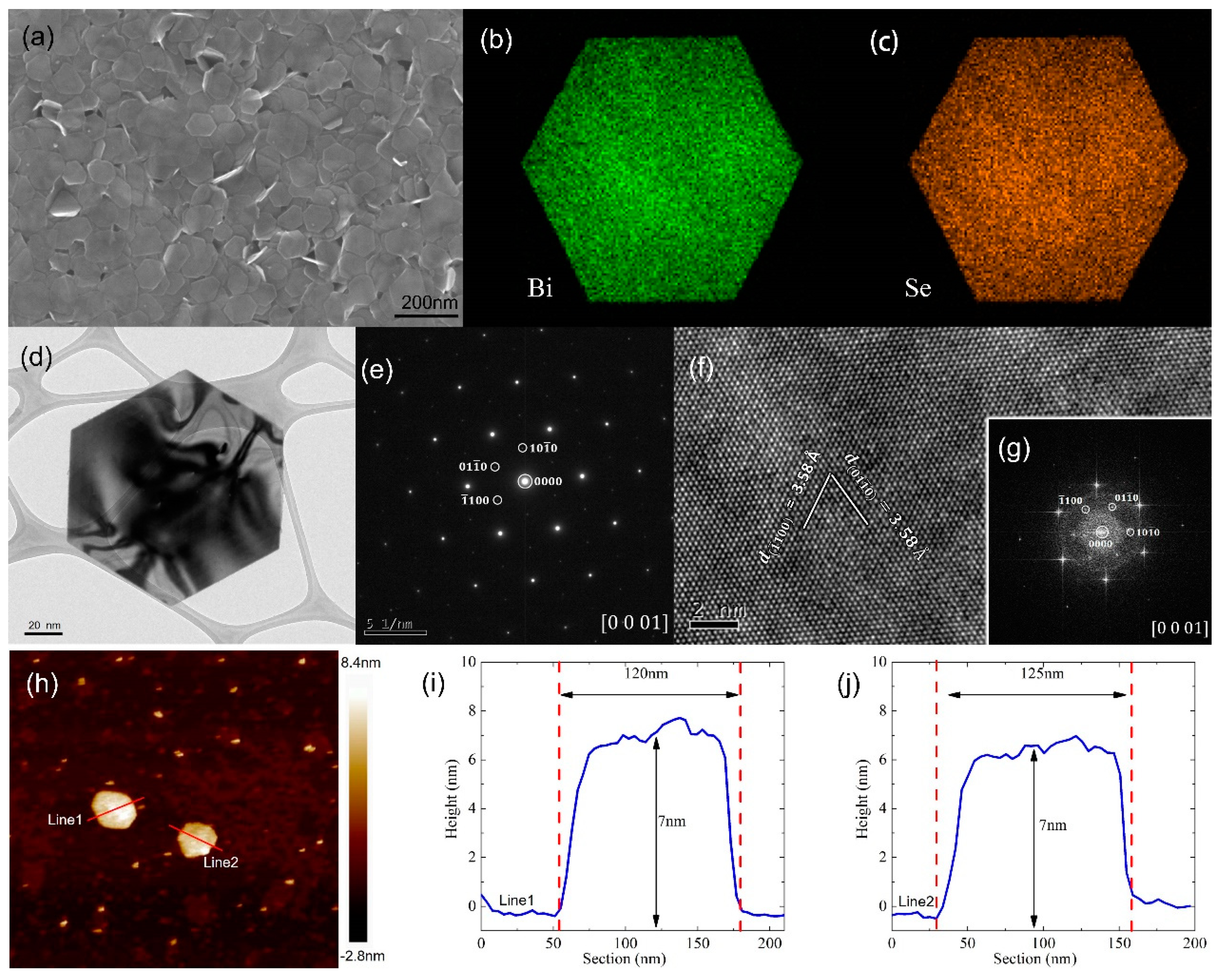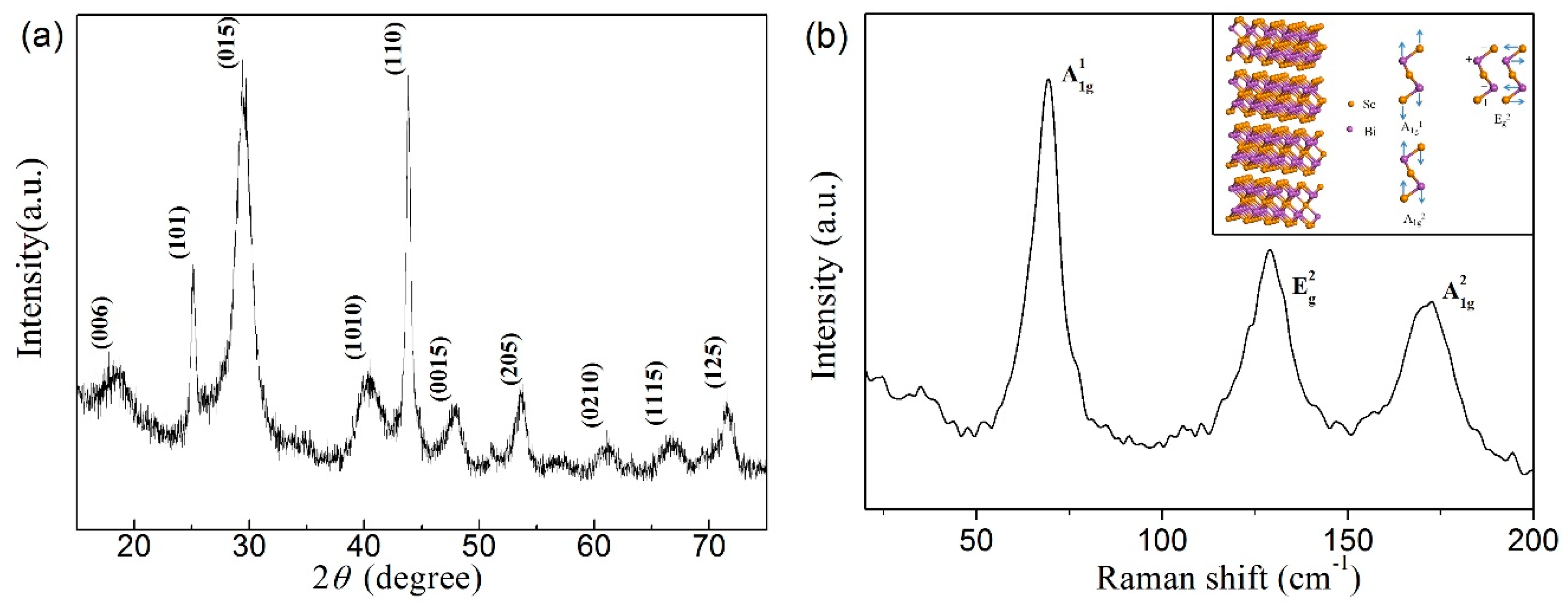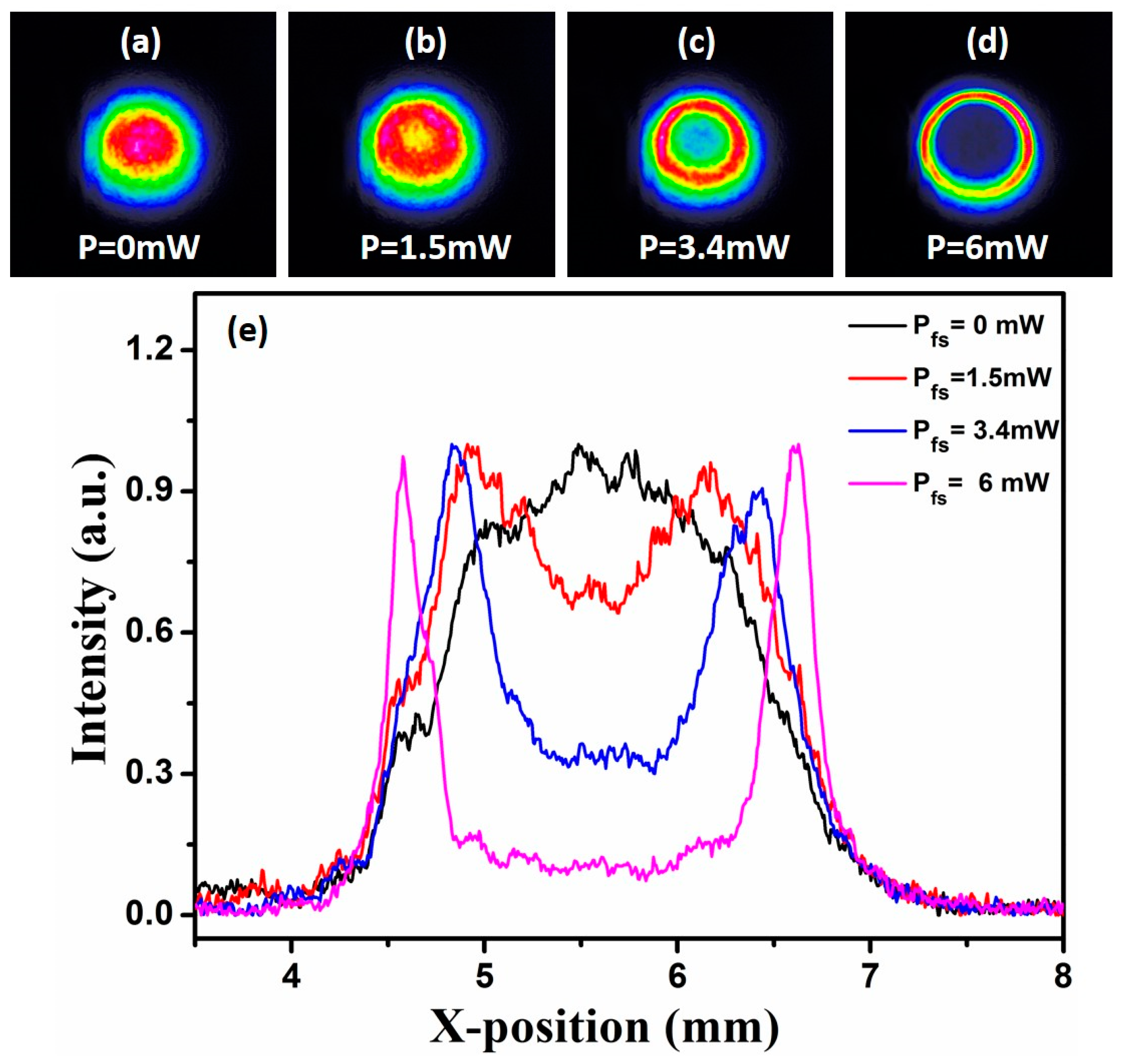Solution Growth of Two-Dimensional Bi2Se3 Nanosheets for Two-Color All-Optical Switching
Abstract
:1. Introduction
2. Material Preparation and Experimental Setup
2.1. Synthesis of Ultrathin Bi2Se3 Nanosheets
2.2. Material Characterizations
2.3. Experimental Setup for Two-Color All-Optical Switching
3. Results and Discussion
4. Conclusions
Acknowledgments
Author Contributions
Conflicts of Interest
References
- Geim, A.K.; Novoselov, K.S. The rise of graphene. Nat. Mater. 2007, 6, 183–191. [Google Scholar] [CrossRef] [PubMed]
- Radisavljevic, B.; Radenovic, A.; Brivio, J.; Giacometti, V.; Kis, A. Single-layer MoS2 transistors. Nat. Nanotechnol. 2011, 6, 147–150. [Google Scholar] [CrossRef] [PubMed]
- Chen, Y.; Analytis, J.; Chu, J.-H.; Liu, Z.; Mo, S.-K.; Qi, X.-L.; Zhang, H.; Lu, D.; Dai, X.; Fang, Z. Experimental realization of a three-dimensional topological insulator, Bi2Te3. Science 2009, 325, 178–181. [Google Scholar] [CrossRef] [PubMed]
- Li, L.; Yu, Y.; Ye, G.J.; Ge, Q.; Ou, X.; Wu, H.; Feng, D.; Chen, X.H.; Zhang, Y. Black phosphorus field-effect transistors. Nat. Nanotechnol. 2014, 9, 372–377. [Google Scholar] [CrossRef] [PubMed]
- Xu, Y.; Wang, Z.; Guo, Z.; Huang, H.; Xiao, Q.; Zhang, H.; Yu, X.-F. Solvothermal Synthesis and Ultrafast Photonics of Black Phosphorus Quantum Dots. Adv. Opt. Mater. 2016, 4, 1223–1229. [Google Scholar] [CrossRef]
- Tan, C.; Cao, X.; Wu, X.-J.; He, Q.; Yang, J.; Zhang, X.; Chen, J.; Zhao, W.; Han, S.; Nam, G.-H.; et al. Recent Advances in Ultrathin Two-Dimensional Nanomaterials. Chem. Rev. 2017, 117, 6225–6331. [Google Scholar] [CrossRef] [PubMed]
- Cao, H.; Venkatasubramanian, R.; Liu, C.; Pierce, J.; Yang, H.; Hasan, M.Z.; Wu, Y.; Chen, Y.P. Topological insulator Bi2Te3 films synthesized by metal organic chemical vapor deposition. Appl. Phys. Lett. 2012, 101, 162104. [Google Scholar] [CrossRef]
- Chen, X.; Ma, X.-C.; He, K.; Jia, J.-F.; Xue, Q.-K. Molecular Beam Epitaxial Growth of Topological Insulators. Adv. Mater. 2011, 23, 1162–1165. [Google Scholar] [CrossRef] [PubMed]
- Goyal, V.; Teweldebrhan, D.; Balandin, A.A. Mechanically-exfoliated stacks of thin films of Bi2Te3 topological insulators with enhanced thermoelectric performance. Appl. Phys. Lett. 2010, 97, 133117. [Google Scholar] [CrossRef]
- Nicolosi, V.; Chhowalla, M.; Kanatzidis, M.G.; Strano, M.S.; Coleman, J.N. Liquid Exfoliation of Layered Materials. Science 2013, 340. [Google Scholar] [CrossRef]
- Xu, H.M.; Chen, G.; Jin, R.C.; Chen, D.H.; Wang, Y.; Pei, J. Green synthesis of Bi2Se3 hierarchical nanostructure and its electrochemical properties. RSC Adv. 2014, 4, 8922–8929. [Google Scholar] [CrossRef]
- Min, Y.; Moon, G.D.; Kim, B.S.; Lim, B.; Kim, J.S.; Kang, C.Y.; Jeong, U. Quick, Controlled Synthesis of Ultrathin Bi2Se3 Nanodiscs and Nanosheets. J. Am. Chem. Soc. 2012, 134, 2872–2875. [Google Scholar] [CrossRef] [PubMed]
- Zhang, J.; Peng, Z.; Soni, A.; Zhao, Y.; Xiong, Y.; Peng, B.; Wang, J.; Dresselhaus, M.S.; Xiong, Q. Raman spectroscopy of few-quintuple layer topological insulator Bi2Se3 nanoplatelets. Nano Lett. 2011, 11, 2407–2414. [Google Scholar] [CrossRef] [PubMed]
- Jiang, Y.; Zhu, Y.; Cheng, G.F. Synthesis of Bi2Se3 Nanosheets by Microwave Heating Using an Ionic Liquid. Cryst. Growth Des. 2006, 6, 2174–2176. [Google Scholar] [CrossRef]
- Hong, S.S.; Kundhikanjana, W.; Cha, J.J.; Lai, K.; Kong, D.; Meister, S.; Kelly, M.A.; Shen, Z.-X.; Cui, Y. Ultrathin topological insulator Bi2Se3 nanoribbons exfoliated by atomic force microscopy. Nano Lett. 2010, 10, 3118–3122. [Google Scholar] [CrossRef] [PubMed]
- Chen, S.; Zhao, C.; Li, Y.; Huang, H.; Lu, S.; Zhang, H.; Wen, S. Broadband optical and microwave nonlinear response in topological insulator. Opt. Mater. Express 2014, 4, 587–596. [Google Scholar] [CrossRef]
- Lu, S.; Zhao, C.; Zou, Y.; Chen, S.; Chen, Y.; Li, Y.; Zhang, H.; Wen, S.; Tang, D. Third order nonlinear optical property of Bi2Se3. Opt. Express 2013, 21, 2072–2082. [Google Scholar] [CrossRef] [PubMed]
- Zhao, C.; Zhang, H.; Qi, X.; Chen, Y.; Wang, Z.; Wen, S.; Tang, D. Ultra-short pulse generation by a topological insulator based saturable absorber. Appl. Phys. Lett. 2012, 101, 211106. [Google Scholar] [CrossRef]
- Soni, A.; Zhao, Y.; Yu, L.; Aik, M.K.K.; Dresselhaus, M.S.; Xiong, Q. Enhanced Thermoelectric Properties of Solution Grown Bi2Te3-xSex Nanoplatelet Composites. Nano Lett. 2012, 12, 1203–1209. [Google Scholar] [CrossRef] [PubMed]
- Son, J.S.; Choi, M.K.; Han, M.-K.; Park, K.; Kim, J.-Y.; Lim, S.J.; Oh, M.; Kuk, Y.; Park, C.; Kim, S.-J. n-Type Nanostructured Thermoelectric Materials Prepared from Chemically Synthesized Ultrathin Bi2Te3 Nanoplates. Nano Lett. 2012, 12, 640–647. [Google Scholar] [CrossRef] [PubMed]
- Mi, J.-L.; Lock, N.; Sun, T.; Christensen, M.; Sondergaard, M.; Hald, P.; Hng, H.H.; Ma, J.; Iversen, B.B. Biomolecule-Assisted Hydrothermal Synthesis and Self-Assembly of Bi2Te3 Nanostring-Cluster Hierarchical Structure. ACS Nano 2010, 4, 2523–2530. [Google Scholar] [CrossRef] [PubMed]
- Liu, X.; Fang, Z.; Zhang, Q.; Huang, R.; Lin, L.; Ye, C.; Ma, C.; Zeng, J. Ethylenediaminetetraacetic acid-assisted synthesis of Bi2Se3 nanostructures with unique edge sites. Nano Res. 2016, 9, 2707–2714. [Google Scholar] [CrossRef]
- Liu, X.; Xu, J.; Fang, Z.; Lin, L.; Qian, Y.; Wang, Y.; Ye, C.; Ma, C.; Zeng, J. One-pot synthesis of Bi2Se3 nanostructures with rationally tunable morphologies. Nano Res. 2015, 8, 3612–3620. [Google Scholar] [CrossRef]
- Zhang, Y.; Hu, L.P.; Zhu, T.J.; Xie, J.; Zhao, X.B. High Yield Bi2Te3 Single Crystal Nanosheets with Uniform Morphology via a Solvothermal Synthesis. Cryst. Growth Des. 2013, 13, 645–651. [Google Scholar] [CrossRef]
- Ota, J.R.; Roy, P.; Srivastava, S.K.; Popovitz-Biro, R.; Tenne, R. A simple hydrothermal method for the growth of Bi2Se3 nanorods. Nanotechnology 2006, 17, 1700–1705. [Google Scholar] [CrossRef] [PubMed]
- Zheng, J.; Yang, Z.; Si, C.; Liang, Z.; Chen, X.; Cao, R.; Guo, Z.; Wang, K.; Zhang, Y.; Ji, J.; et al. Black Phosphorus Based All-Optical-Signal-Processing: Toward High Performances and Enhanced Stability. ACS Photonics 2017, 4, 1466–1476. [Google Scholar] [CrossRef]
- Lu, S.; Ge, Y.; Sun, Z.; Huang, Z.; Cao, R.; Zhao, C.; Wen, S.; Fan, D.; Li, J.; Zhang, H. Ultrafast nonlinear absorption and nonlinear refraction in few-layer oxidized black phosphorus. Photonics Res. 2016, 4, 286. [Google Scholar] [CrossRef]
- Wu, Y.; Wu, Q.; Sun, F.; Cheng, C.; Meng, S.; Zhao, J. Emergence of electron coherence and two-color all-optical switching in MoS2 based on spatial self-phase modulation. Proc. Natl. Acad. Sci. USA 2015, 112, 11800–11805. [Google Scholar] [CrossRef] [PubMed]
- Li, X.; Liu, R.; Xie, H.; Zhang, Y.; Lyu, B.; Wang, P.; Wang, J.; Fan, Q.; Ma, Y.; Tao, S.; et al. Tri-phase all-optical switching and broadband nonlinear optical response in Bi2Se3 nanosheets. Opt. Express 2017, 25, 18346–18354. [Google Scholar] [CrossRef] [PubMed]
- Xu, Y.; Wang, W.; Ge, Y.; Guo, H.; Zhang, X.; Chen, S.; Deng, Y.; Lu, Z.; Zhang, H. Stabilization of Black Phosphorous Quantum Dots in PMMA Nanofiber Film and Broadband Nonlinear Optics and Ultrafast Photonics Application. Adv. Funct. Mater. 2017, 27, 1702437. [Google Scholar] [CrossRef]
- Li, X.; Hu, K.; Lyu, B.; Zhang, J.; Wang, Y.; Wang, P.; Xiao, S.; Gao, Y.; He, J. Enhanced Nonlinear Optical Response of Rectangular MoS2 and MoS2/TiO2 in Dispersion and Film. J. Phys. Chem. C 2016, 120, 18243–18248. [Google Scholar] [CrossRef]
- Shi, B.; Miao, L.; Wang, Q.; Du, J.; Tang, P.; Liu, J.; Zhao, C.; Wen, S. Broadband ultrafast spatial self-phase modulation for topological insulator Bi2Te3 dispersions. Appl. Phys. Lett. 2015, 107, 151101. [Google Scholar] [CrossRef]
- Zhuang, A.; Zhao, Y.; Liu, X.; Xu, M.; Wang, Y.; Jeong, U.; Wang, X.; Zeng, J. Controlling the lateral and vertical dimensions of Bi2Se3 nanoplates via seeded growth. Nano Res. 2014, 8, 246–256. [Google Scholar] [CrossRef]
- Min, Y.; Park, G.; Kim, B.; Giri, A.; Zeng, J.; Roh, J.W.; Kim, S.I.; Lee, K.H.; Jeong, U. Synthesis of Multi-Shell Nanoplates by Consecutive Epitaxial Growth of Bi2Se3 and Bi2Te3 Nanoplates and Enhanced Thermoelectric Properties. ACS Nano 2015, 9, 6843–6853. [Google Scholar] [CrossRef] [PubMed]
- Kong, D.; Dang, W.; Cha, J.J.; Li, H.; Meister, S.; Peng, H.; Liu, Z.; Cui, Y. Few-layer nanoplates of Bi2Se3 and Bi2Te3 with highly tunable chemical potential. Nano Lett. 2010, 10, 2245–2250. [Google Scholar] [CrossRef] [PubMed]
- Steinberg, H.; Gardner, D.R.; Lee, Y.S.; Jarillo-Herrero, P. Surface state transport and ambipolar electric field effect in Bi2Se3 nanodevices. Nano Lett. 2010, 10, 5032–5036. [Google Scholar] [CrossRef] [PubMed] [Green Version]
- Ambrosi, A.; Sofer, Z.; Luxa, J.; Pumera, M. Exfoliation of Layered Topological Insulators Bi2Se3 and Bi2Te3 via Electrochemistry. ACS Nano 2016, 10, 11442–11448. [Google Scholar] [CrossRef] [PubMed]
- Wang, D.; Yu, D.; Mo, M.; Liu, X.; Qian, Y. Preparation and characterization of wire-like Sb2Se3 and flake-like Bi2Se3 nanocrystals. J. Cryst. Growth 2003, 253, 445–451. [Google Scholar] [CrossRef]
- Yuan, J.; Zhao, M.; Yu, W.; Lu, Y.; Chen, C.; Xu, M.; Li, S.; Loh, K.P.; Bao, Q. Raman Spectroscopy of Two-Dimensional Bi(2)TexSe3-x Platelets Produced by Solvothermal Method. Materials 2015, 8, 5007–5017. [Google Scholar] [CrossRef] [PubMed]
- Shahil, K.M.F.; Hossain, M.Z.; Goyal, V.; Balandin, A.A. Micro-Raman spectroscopy of mechanically exfoliated few-quintuple layers of Bi2Te3, Bi2Se3, and Sb2Te3 materials. J. Appl. Phys. 2012, 111, 054305. [Google Scholar] [CrossRef]
- Jana, M.K.; Biswas, K.; Rao, C.N. Ionothermal synthesis of few-layer nanostructures of Bi2Se3 and related materials. Chemistry 2013, 19, 9110–9113. [Google Scholar] [CrossRef] [PubMed]
- Dang, W.; Peng, H.; Li, H.; Wang, P.; Liu, Z. Epitaxial heterostructures of ultrathin topological insulator nanoplate and graphene. Nano Lett. 2010, 10, 2870–2876. [Google Scholar] [CrossRef] [PubMed]
- Dun, C.; Hewitt, C.A.; Huang, H.; Xu, J.; Montgomery, D.S.; Nie, W.; Jiang, Q.; Carroll, D.L. Layered Bi2Se3 nanoplate/polyvinylidene fluoride composite based n-type thermoelectric fabrics. ACS Appl. Mater. Interfaces 2015, 7, 7054–7059. [Google Scholar] [CrossRef] [PubMed]







© 2017 by the authors. Licensee MDPI, Basel, Switzerland. This article is an open access article distributed under the terms and conditions of the Creative Commons Attribution (CC BY) license (http://creativecommons.org/licenses/by/4.0/).
Share and Cite
Wu, X.; Tan, C.; Wang, Q.; Guo, Y.; Wang, D.; Wang, Y.; Meng, D. Solution Growth of Two-Dimensional Bi2Se3 Nanosheets for Two-Color All-Optical Switching. Materials 2017, 10, 1332. https://doi.org/10.3390/ma10111332
Wu X, Tan C, Wang Q, Guo Y, Wang D, Wang Y, Meng D. Solution Growth of Two-Dimensional Bi2Se3 Nanosheets for Two-Color All-Optical Switching. Materials. 2017; 10(11):1332. https://doi.org/10.3390/ma10111332
Chicago/Turabian StyleWu, Xinghua, Chao Tan, Qingkai Wang, Yanyan Guo, Dianyuan Wang, Yongqian Wang, and Dawei Meng. 2017. "Solution Growth of Two-Dimensional Bi2Se3 Nanosheets for Two-Color All-Optical Switching" Materials 10, no. 11: 1332. https://doi.org/10.3390/ma10111332




